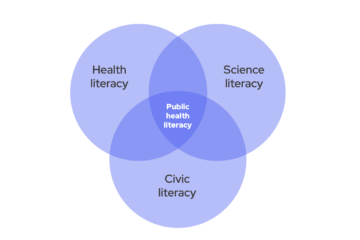I’ve been fortunate to work with dedicated health professionals in many different capacities. In my roles as a pediatric emergency physician, a state health commissioner, a hospital executive and the medical director of a large for-profit health plan, I’ve seen many examples of collaboration, but also, unfortunately, many missed opportunities.
Building healthier communities where people can achieve their optimal health must involve stakeholders from public health, health care, business, elected officials and other sectors. But too often, misperceptions and preconceived notions about potential partners and their motivations get in the way of effective, trusting partnerships.
Fortunately, public health practitioners are well positioned to address these obstacles and create new opportunities. The same skills and values that make us successful at working with communities and populations — compassion, respect, analysis, community-building — can and should be applied to partners in health care, government and other sectors.
New partners often begin meetings by talking over and around each other, using phrases and terminology that may be a foreign language and even foreign culture to others. These behaviors can alienate groups before they have even begun to explore relationships and collaborations. I think we can all learn from Aaron Burr’s line from the musical “Hamilton”: “Talk less, smile more.” Effective partners start with a spirit of openness and an interest in understanding what others bring to the table. And that starts with mutual respect.
I felt the distrust of other sectors when I first went to work for Anthem BlueCross BlueShield. Many of my former clinical and public health colleagues asked me why I had joined the “dark side.” While I know it was meant in jest (most of the time), it’s hard to deny that insurance companies don’t have the best reputations within these communities. But when I was at Anthem, I saw people at all levels who were just as committed to improving lives as my former colleagues in pediatrics and public health, and I realized that we all shared a common goal of improving people’s health and lives. After learning about the company’s drivers, concerns and goals, I was able to propose public health solutions that made business sense and were likely to improve health outcomes.
In this new role, I knew I’d need to learn the language of my new “health insurance community.” I first listened and asked a lot of questions so I could understand the leadership group’s key drivers, concerns and goals. Only then was I able to discuss a public health problem — early elective deliveries (EED) — in a way that engaged this group. I appealed to them as thoughtful and accountable leaders for the plan and their communities and explained how it would improve the health of babies throughout Virginia.
I told them about the impact of EED on NICU days (a key cost driver); on childhood outcomes, including ADHD (another cost driver); and on parental time away from work (a concern of our employee customers). I made sure to not lecture but to appeal to their business sense and their concern for families.
By describing the problem using their language and data, I was able to get buy-in for a plan to lead a multidisciplinary group to proactively and voluntarily put in place hospital protocols that were led and implemented by physicians, beginning in 2014. In 2012, Virginia’s early elective delivery rate had been 8 percent. By 2016, the state had the lowest rate in the country — 1.3 percent.
Knowing that all sectors bring needed skills and perspectives, I’d make the following recommendations for strong cross-sector partnerships:
Approach potential partners with humility and openness.
The core principles of public health practice are community engagement, cultural humility and collaboration. We respect our communities and engage them in conversations about how best to address the health issues that affect them. We should bring that same humility and respect to our partners and potential partners.
Understand your partners’ needs.
Before asking for their help, take time to understand their strategic objectives, their priorities and their motivations. Ask what success looks like for them. What problems can you help them solve?
Recognize your own biases and preconceived notions.
Mutually beneficial partnerships require mutual respect. Admit your own biases and preconceived notions about other people and other sectors.
By recognizing the obstacles that get in our way, we’ll build effective and non-traditional partnerships that will build healthier communities and better health for all.




